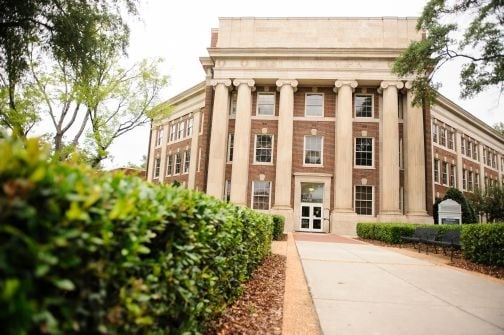You have /5 articles left.
Sign up for a free account or log in.

Autherine Lucy Hall (formerly Bibb Graves Hall) at the University of Alabama.
University of Alabama
The University of Alabama fumbled its recent changing of the name of the building that houses the College of Education.
The building was originally named after a once Grand Cyclops of the Ku Klux Klan and two-term governor of Alabama, Bibb Graves. Following sustained activism from students pushing for a more inclusive campus, the University of Alabama system Board of Trustees voted Feb. 3 to rename the building after the first Black University of Alabama student, Autherine Lucy Foster—but rather than remove Graves’s name entirely, the board initially opted to rename the building Lucy-Graves Hall.
The decision was met with swift critique and pushback, and the Board of Trustees voted Friday to remove Graves’s name completely and rename the building Autherine Lucy Hall. The damage, however, had already been done. By initially keeping Graves’s name, UA ignored the unwritten university playbook of responding to demands for racial equity.
Any playbook worth its salt involves an element of deception. Playbooks are about trickery. Playbooks outline methods to disguise intentions within the formations of players. Consider a play-action fake in football. A fake handoff is used to distract opponents from the true intention, a pass. The handoff was never the goal. The goal was deception and distraction.
The University of Alabama is like many other historically white institutions of higher education. HWIs are alike in that they have a history of alienating and excluding nonwhite students. The policies, traditions, symbols and practices at HWIs were designed by and for white people. HWIs also use a similar playbook to respond to demands for racial equity. Across the nation, such universities leverage racial symbols rather than taking meaningful, more costly, steps to racial justice and redress.
The foundational critical race scholar Derrick Bell coined the term “racial symbols.” Based on Bell’s work, I have described racial symbols as “policies, memorials, statements or leaders that have abstract or symbolic value but do little to alter the structural condition and material realities of racially oppressed peoples.” In higher education, racial symbolism can take the form of renaming buildings, removing statues or appointing a diversity officer. Such symbols are positive steps toward racial justice: students should not have to take classes in buildings named after Ku Klux Klan members or enslavers who did not want Black people on campuses. But symbolic change is limited. Symbols can also be trick plays for the university. They offer the guise of progress without the sustained investment or support for Black students needed for meaningful change. Progressive symbols are grafted onto campus structures and buildings while the foundation of university structures remains unchanged.
The University of Alabama has made a half-hearted attempt at the typical trick play of using symbolism to appease student activists. But UA is telegraphing their play. Students and alumni can see through name changes for what they are. The initial decision to add Foster’s name while keeping Graves’s was both an empty gesture toward racial redress and a bold assertion that a Ku Klux Klan leader remained worthy of memorialization. Beyond the poorly veiled racial symbolism of this renaming, serious racial climate issues persist at UA.
Consider the pressing issues of racism UA needs to address. Although Black people make up 26.8 percent of the state of Alabama’s population, Black students comprise only 10.8 percent of UA’s undergraduate enrollment. Black students have among the lowest six-year graduation rates at UA, a rate of just 53.9 percent. The university only moved to integrate its sororities as recently as 2013. These problems are symptomatic of the university’s failure to take measurable steps to support Black students and address issues of racism on campus. A name change—even the complete removal of Graves’s name—will not begin to address any of these issues.
Certainly, the initial decision to keep Graves’s name on a university building is rooted in racism. As a Black man, I cannot see any worth in meditating upon the merits of a high-ranking Ku Klux Klan member. In conjoining a Black woman’s name with the name of a Grand Cyclops of the Ku Klux Klan, the University of Alabama, as the saying goes, was “saying the quiet part loud.”
I am glad the university has now completely dropped Graves’s name. Yet, the messaging from this fumbled name change is clear. The university has no genuine interest in racial justice efforts that could lead to meaningful, foundational reform.




